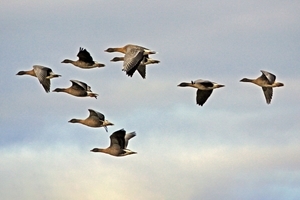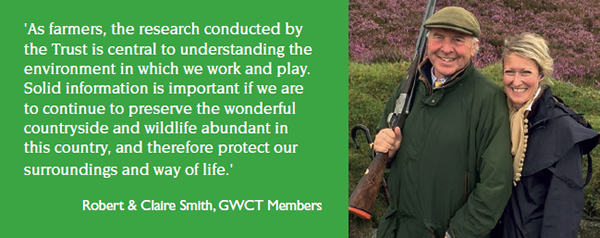Pink-footed goose
Let me set the scene.
 It is mid-winter and the light is fading over the north Norfolk coast – the wind has fallen still. A few wispy clouds have become blushed with a rosy red and the temperature is falling fast. I stand still and listen.
It is mid-winter and the light is fading over the north Norfolk coast – the wind has fallen still. A few wispy clouds have become blushed with a rosy red and the temperature is falling fast. I stand still and listen.
Is that them? The distant whisperings of what sounds like hunting hounds faintly reaches my ears. Yes, that’s them. The pinkfeet have taken to the wing and are on their way!
Before too long a small advanced party of a dozen or so fly past in a classic V-formation, cackling and calling to each other as they pass overhead on their way to roost out on the Wash.
But the main event is still to materialise and I can increasingly hear them coming. Then I pick them up in my binoculars, masses of them.
Before long the whole sky is full of skeins of geese, thousands and thousands of them. Their collective chattering completely dominates the surroundings, which, at its peak, becomes ear-shatteringly loud!
Every time I experience this incredible spectacle, with pink-foot numbers nowadays reaching some 70,000 in Norfolk, I find myself beaming away with ridiculous pleasure at this joyous show!
Yet, in what seems like only a few moments later, the whole aerial display is over and a still peace descends across the shoreline once more.
The medium sized pink-footed goose (Anser brachyrhynchus) is coloured a pinkish grey with a dark head and neck, a pink bill and pink feet and legs. There are two discrete populations: the Greenland and Iceland breeders, which winter in the UK; and the Svalbard (a Norwegian archipelago between mainland Norway and the North Pole) breeders, which migrate to the Netherlands, Belgium and Denmark to over-winter.
The UK wintering population is around 360,000 individuals, usually found in the vicinity of large estuaries, such as on the east Scottish coast, Wash, Ribble and the Solway. I have, for instance, watched a similar display to Norfolk’s taking place across the Montrose basin, although Norfolk perhaps has the edge on the sheer numbers involved!
Pink-footed geese usually spend the daylight hours feeding on farmland, consuming grain, grass and potatoes. One of the main reasons why such large numbers are attracted to Norfolk is that farmers harvesting sugar beet there purposely leave the green tops on the ground for the geese to eat. It will be interesting to see if contract and funding changes post-Brexit continue to make sugar beet a profitable crop for East Anglian farmers to grow. If the crop declines or indeed disappears, it could have an impact on the numbers of geese visiting the area.
One way to attract geese to specific ‘sacrificial’ grazing sites, so that they do not impact too much on commercial crops, is to fertilise grass by applying around 80kg/ha. By picking grass fields with an ‘open’ aspect and ensuring that the grass is at a favoured height, the nitrogen fertiliser makes the grass become ‘soft and sweet’, exactly what the geese love to eat! Farmers in some parts of the country are paid to produce grass along these lines.
Should you come across a flock of pinkfeet feeding, scan them with your binoculars, as you may well see some supporting conspicuous neck rings bearing unique two- or three-character codes. Also some may have large leg rings, also bearing similar codes. You can report these sightings to colourmarkedwildfowl@wwt.org.uk and you will get notified where it was first ringed and also other sightings of where it has been spotted.
This helps monitor the population and indicate what habitats the birds are using through the winter months. Also, of course, this work can show where individuals go to breed each year. Pink-footed geese are doing well at the moment, with the UK long-term trend (1989/90-2014/15) showing a 120% increase.
Ringing has also shown us how long a pinkfoot can live. One individual was ringed as an adult on 29 October 1959 in Perth and Kinross, and found dead in Midlothian on 5 June 1998, making it at least 38 years old.
If you have a ‘bucket list’ of things you really want to do before too long, which includes luxurious holiday destinations or expensive London shows, that’s fine. But maybe you should now also add a trip to see thousands upon thousands of pinkfeet, raucously flighting across the evening sky on their way to roost out on the marshes. It is an all-encompassing experience that will stay with you for a very long time! What is more, it’s free!
Peter Thompson
Advisory
Read more from Peter Thompson at his blog.
Photo credit: Andy Hawkins
What do we do?
- We use science to promote game and wildlife management as an essential part of nature conservation.
- We develop scientifically researched game and wildlife management techniques.
- We promote our work to conservationists, including farmers and landowners and offer an on-site advisory service on all aspects of game and wildlife management, so that Britain’s countryside and its wildlife are enhanced for the public benefit.
- We influence government policy with sound science that creates progressive and effective policies.
- We support best practice for field sports that contribute to improving the biodiversity of the countryside.
Donate by Credit or Debit Card >>
Got a PayPal account? Donate faster here:


What do we believe?
- Scientific research should underpin sustainable conservation practice.
- Game and wildlife management is the foundation of good conservation.
- Field sports (in particular shooting and fishing) can contribute substantially to the conservation of landscape, habitat and wildlife.
- Humane and targeted predator control is an essential part of effective game and wildlife conservation.
- We utterly oppose those who engage in wildlife crime.
- Good conservation goes hand-in-hand with economic land use.
How your money is spent
- We spent over £5m on vital game and wildlife research and public education in 2017.
Donate by Credit or Debit Card >>
Got a PayPal account? Donate faster here:
